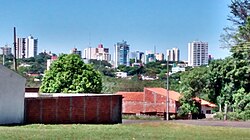Cianorte
| City of Cianorte | |||
|---|---|---|---|
 |
|||
|
|||
| Nickname(s): Capital of the National Clothing | |||
| Country |
|
||
| Region | South | ||
| State | Paraná | ||
| Founded | July 26, 1955 | ||
| Area | |||
| • City | 811.7 km2 (313.4 sq mi) | ||
| Elevation | 490 m (1,610 ft) | ||
| Population (2009) | |||
| • City | 100,269 | ||
| • Density | 79.4/km2 (206/sq mi) | ||
| • Metro | 134,426 | ||
| Time zone | UTC-3 | ||
| HDI (2000) | 0.818 – high | ||
| Website | Cianorte, Paraná | ||
Cianorte is a city in northwest Paraná, Brazil, with an estimated population of 76,456, according to the Brazilian Institute of Geography and Statistics in 2013.
The city was planned and founded by the Company for the Improvement of the North of Paraná (Companhia Melhoramentos Norte do Paraná), a British company for which it was named. In the beginning of the 20th century the region was dominated by a subtropical forest and totally wild, except for the Road of Peabiru, used by the Portuguese to connect the Guaira region, further west, to the coast. The road existed from the 17th century, but the first reported contact with the natives of the region, the Xetas, was in the 1930s. The Xetas, a group of three or four hundred, had their own language, and were early Iron Age in culture. The group vanished after they were contacted by the British in controversial and unexplained circumstances.
In the 1940s the English company drew the city plan and split the region into very small farms. At this time, the city was redivided and part of the city and the areas around were sold to immigrants, mainly Italian-Brazilians and Japanese-Brazilians of second or third generation from São Paulo. Those immigrants were primarily poor ordinary workers in the huge coffee farms of São Paulo, and perceived the inexpensive land in Cianorte as their big opportunity in life. They built houses and schools, temples and businesses. The city become a municipality, which, under Brazilian laws, allows the area to extend its political structure.
The Municipality of Cianorte was created through the State Law no. 2.412 of July 26, 1955. Cianorte then had around 11,000 inhabitants, mostly in the countryside. The economy was based on coffee. A disastrous frost in the winter of 1975, in which temperatures dropped below zero for the first time in recorded weather, destroyed the coffee plantations. Coffee trees take around five years to start producing, and so the economy went through a terrible crisis. Population fell and businesses closed.
The disaster transformed the city. People opened clothing factories and shops in their garages and back yards. By the time agriculture began to recover, some of the mini-factories had grown to medium-sized companies, and the work force was already devoted to those. During the next decades some of those garage enterprises turned into huge factories that today sell clothes to the entire country, and export a significant portion to several countries. Shop owners from several states of Brazil visit Cianorte in the beginning of every season to purchase clothing, so hotels and restaurants are opened specially for them.
...
Wikipedia


